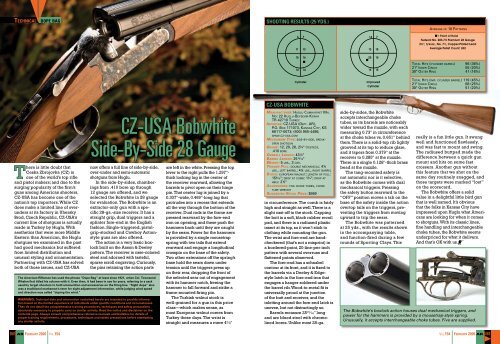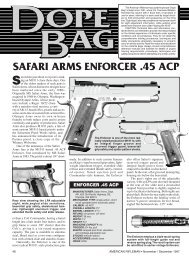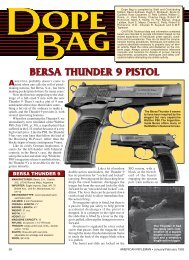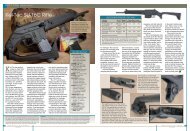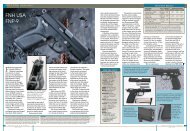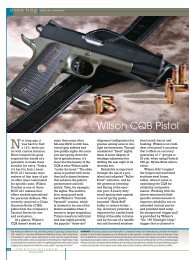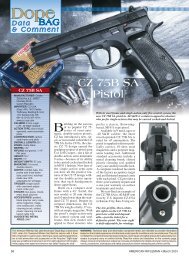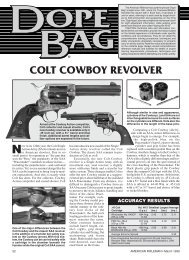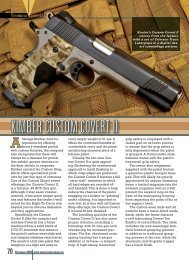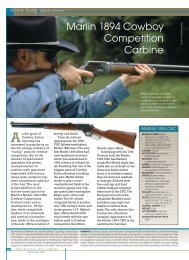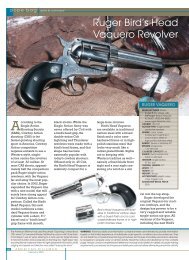CZ-USA Bobwhite Side-By-Side 28 Gauge
CZ-USA Bobwhite Side-By-Side 28 Gauge - The National Firearms ...
CZ-USA Bobwhite Side-By-Side 28 Gauge - The National Firearms ...
- No tags were found...
Create successful ePaper yourself
Turn your PDF publications into a flip-book with our unique Google optimized e-Paper software.
Technical dope bag<br />
SHOOTING RESULTS (25 YDS.)<br />
6 7<br />
11 13<br />
15 16<br />
14 14<br />
Cylinder<br />
14 7<br />
13 15<br />
25 15<br />
15 15<br />
Improved<br />
Cylinder<br />
Average of 10 Patterns<br />
= Point of Hold<br />
Federal No. <strong>28</strong>3-7.5 Premium <strong>28</strong> <strong>Gauge</strong><br />
2 3 ⁄4", 3/4-oz., No. 7 1 ⁄2, Copper-Plated Lead<br />
Average Pellet Count: 262<br />
Total Hits (cylinder barrel) 96 (36%)<br />
21" Inner Circle 55 (20%)<br />
30" Outer Ring 41 (16%)<br />
Total Hits (imp. cylinder barrel) 119 (45%)<br />
21" Inner Circle 68 (25%)<br />
30" Outer Ring 51 (20%)<br />
There is little doubt that<br />
Ceska Zbrojovka (<strong>CZ</strong>) is<br />
one of the world’s top rifle<br />
and pistol makers; and due to the<br />
surging popularity of the firm’s<br />
guns among American shooters,<br />
<strong>CZ</strong>-<strong>USA</strong> has become one of the<br />
nation’s top importers. While <strong>CZ</strong><br />
does make a limited line of overunders<br />
at its factory in Uhersky<br />
Brod, Czech Republic, <strong>CZ</strong>-<strong>USA</strong>’s<br />
current line of shotguns is actually<br />
made in Turkey by Huglu. With<br />
aesthetics that were more Middle<br />
Eastern than American, the Huglu<br />
shotguns we examined in the past<br />
had good mechanics but suffered<br />
from limited distribution and<br />
unusual styling and ornamentation.<br />
Partnering with <strong>CZ</strong>-<strong>USA</strong> has solved<br />
both of those issues, and <strong>CZ</strong>-<strong>USA</strong><br />
<strong>CZ</strong>-<strong>USA</strong> <strong>Bobwhite</strong><br />
<strong>Side</strong>-<strong>By</strong>-<strong>Side</strong> <strong>28</strong> <strong>Gauge</strong><br />
now offers a full line of side-by-side,<br />
over-under and semi-automatic<br />
shotguns from Huglu.<br />
In the side-by-sides, chamberings<br />
from .410 bore up through<br />
12 gauge are offered, and we<br />
selected the <strong>Bobwhite</strong> in <strong>28</strong> gauge<br />
for evaluation. The <strong>Bobwhite</strong> is an<br />
extractor-only gun with a specific<br />
<strong>28</strong>-ga.-size receiver. It has a<br />
straight grip, dual triggers and a<br />
splinter fore-end in the English<br />
fashion. Single-triggered, pistolgrip-stocked<br />
and Cowboy Actionstyle<br />
guns are also offered.<br />
The action is a very basic boxlock<br />
built on the Anson & Deeley<br />
pattern. The receiver is case-colored<br />
steel and adorned with tasteful,<br />
sparse scroll engraving. Curiously,<br />
the pins retaining the action parts<br />
The American Rifleman has used the phrase “Dope Bag” at least since 1921, when Col. Townsend<br />
Whelen first titled his column with it. Even then, it had been in use for years, referring to a sack<br />
used by target shooters to hold ammunition and accessories on the firing line. “Sight dope” also<br />
was a traditional marksman’s term for sight adjustment information, while judging wind speed<br />
and direction was called “doping the wind.”<br />
WARNING: Technical data and information contained herein are intended to provide information<br />
based on the limited experience of individuals under specific conditions and circumstances.<br />
They do not detail the comprehensive training procedures, techniques and safety precautions<br />
absolutely necessary to properly carry on similar activity. Read the notice and disclaimer on the<br />
contents page. Always consult comprehensive reference manuals and bulletins for details of<br />
proper training requirements, procedures, techniques and safety precautions before attempting<br />
any similar activity.<br />
are left in the white. Pressing the top<br />
lever to the right pulls the 1.297"-<br />
thick locking lug in the center of<br />
the receiver rearward, allowing the<br />
barrels to pivot open on their hinge<br />
pin. That center lug is joined by a<br />
0.307"-wide, 0.469"-long lug that<br />
protrudes into a recess that extends<br />
all the way through the bottom of the<br />
receiver. Dual rods in the frame are<br />
pressed rearward by the fore-end<br />
iron on opening, and these push the<br />
hammers back until they are caught<br />
by the sears. Power for the hammers<br />
is provided by a single mousetrap<br />
spring with two tails that extend<br />
rearward and engage a longitudinal<br />
crosspin on the base of the safety.<br />
Two other extensions off the spring’s<br />
base hold the sears down under<br />
tension until the triggers press up<br />
on their rear, dropping the front of<br />
the selected sear out of engagement<br />
with its hammer notch, freeing the<br />
hammer to fall forward and strike a<br />
frame-mounted firing pin.<br />
The Turkish walnut stock is<br />
well-grained for a gun in this price<br />
class—which makes sense, as<br />
most European walnut comes from<br />
Turkey these days. The wrist is<br />
straight and measures a mere 4 7 ⁄8"<br />
<strong>CZ</strong>-<strong>USA</strong> BOBWHITE<br />
Manufacturer: Huglu Cumhuriyet Mh.<br />
No: 22 Huglu-Beysehir-Konya<br />
TR-42710 Turkey<br />
Importer: <strong>CZ</strong>‐<strong>USA</strong> (Dept. AR),<br />
P.O. Box 171073, Kansas City, KS<br />
66117‐0073; (800) 955‐4486;<br />
www.cz‐usa.com<br />
Mechanism Type: side-by-side, breakopen<br />
shotgun<br />
<strong>Gauge</strong>: 12, 20, <strong>28</strong>, 2 3 ⁄4" (tested),<br />
.410 bore<br />
Overall Length: 43 1 ⁄8"<br />
Barrel Length: 25 15 ⁄16"<br />
Weight: 5 lbs., 3 ozs.<br />
Trigger Pull: double mechanical: 4½<br />
lbs., left barrel; 4¼ lbs., right barrel<br />
Stock: european walnut; length of pull:<br />
15 9 ⁄16"; drop at comb: 1 3 ⁄4"; drop at<br />
heel: 2½"<br />
Accessories: five choke tubes, choke<br />
tube wrench<br />
Suggested Retail Price: $869<br />
in circumference. The comb is fairly<br />
high and straight as well. There is a<br />
slight cast-off to the stock. Capping<br />
the butt is a soft, black rubber recoil<br />
pad, and there is a radiused plastic<br />
insert at its top, so it won’t stick to<br />
clothing while mounting the gun.<br />
The wrist and fore-end are handcheckered<br />
(that’s not a misprint) in<br />
a bordered-point, 20-line-per-inch<br />
pattern with several overruns and<br />
flattened points observed.<br />
The fore-end has a schnabel<br />
contour at its front, and it is fixed to<br />
the barrels via a Deeley & Edgestyle<br />
latch in the fore-end iron that<br />
engages a hanger soldered under<br />
the barrel rib. Wood-to-metal fit is<br />
universally proud at the junction<br />
of the butt and receiver, and the<br />
inletting around the fore-end latch is<br />
uneven, but not distractingly so.<br />
Barrels measure 25 15 ⁄16" long<br />
and are blued steel with chromelined<br />
bores. Unlike most <strong>28</strong>-ga.<br />
side-by-sides, the <strong>Bobwhite</strong><br />
accepts interchangeable choke<br />
tubes, so its barrels are noticeably<br />
wider toward the muzzle, with each<br />
measuring 0.73" in circumference<br />
at the choke tubes vs. 0.651" behind<br />
them. There is a solid-top rib lightly<br />
grooved at its top to reduce glare,<br />
and it tapers from 0.379" at the<br />
receiver to 0.<strong>28</strong>5" at the muzzle.<br />
There is a single 0.1<strong>28</strong>"-thick brass<br />
bead at the muzzle.<br />
The tang-mounted safety is<br />
not automatic nor is it selective,<br />
as the <strong>Bobwhite</strong> comes with dual<br />
mechanical triggers. Pressing<br />
the safety button rearward to the<br />
“OFF” position moves a tab on the<br />
base of the safety inside the action<br />
overtop tails on the triggers, preventing<br />
the triggers from moving<br />
upward to trip the sears.<br />
The <strong>Bobwhite</strong> was patterned<br />
at 25 yds., with the results shown<br />
in the accompanying table,<br />
and function-fired during a few<br />
rounds of Sporting Clays. This<br />
really is a fun little gun. It swung<br />
well and functioned flawlessly,<br />
and was fast to mount and swing.<br />
The radiused buttpad made the<br />
difference between a quick gun<br />
mount and hits on some fast<br />
crossers. Another gun without<br />
this feature that we shot on the<br />
same day routinely snagged, and<br />
those targets were marked “lost”<br />
on the scorecard.<br />
The <strong>Bobwhite</strong> offers a solid<br />
value in a delightful little bird gun<br />
that is well named. It’s obvious<br />
that the folks in Kansas City have<br />
impressed upon Huglu what Americans<br />
are looking for when it comes<br />
to shotguns. With its classic lines,<br />
fine handling and interchangeable<br />
choke tubes, the <strong>Bobwhite</strong> seems<br />
underpriced for what it delivers.<br />
And that’s OK with us.<br />
The <strong>Bobwhite</strong>’s boxlock action houses dual mechanical triggers, and<br />
power for the hammers is provided by a mousetrap-style spring.<br />
Unusually, it accepts interchangeable choke tubes. Five are supplied.<br />
068 AR February 2006 Vol.154 Vol.154 February 2006 AR 069
dope bag<br />
Remington 7615P<br />
Pump-Action Rifle<br />
Although offering fast operation<br />
and simplicity of use,<br />
slide- or pump-action<br />
center-fire rifles are not nearly as<br />
common as their shotgun brethren.<br />
Within this niche market, however,<br />
the Remington 7600 series of centerfire<br />
rifles has proven to be one of<br />
the more popular because of its<br />
combination of “user-friendliness”<br />
and affordability.<br />
Recognizing the strengths of<br />
this rifle design, Remington’s Law<br />
Enforcement Division is offering<br />
two Duty/Patrol variants of<br />
the 7600 rifle: the 7600P in .308<br />
Win. and the 7615P in .223 Rem.,<br />
tested here. The 7615P is available<br />
Remington fitted the 7615P’s magazine<br />
well adapter into the standard 7600 series<br />
of rifles, making for an ingeniously simple<br />
solution to the issue of adapting the rifle<br />
to use AR-15/M16 magazines. The piece<br />
fitted to the upper rear section of the<br />
adapter is what Remington calls a “stripper<br />
guide.” It strips a round from the mag<br />
while then holding the next round down<br />
as the action continues to close.<br />
through any distributor that carries<br />
Remington’s law enforcement line.<br />
The 7615P offers similar operation<br />
to a standard Remington Model 870<br />
with the same slide-action operation,<br />
cross-bolt safety at the rear of<br />
the trigger guard and slide action<br />
release at the front of the trigger<br />
guard. According to Remington,<br />
these similarities have made for<br />
significantly easier transitioning<br />
from the 870 for officers who may<br />
not have had much prior experience<br />
with rifles. Apparently, the .223 Rem.<br />
chambering has also made it popular<br />
with smaller-statured officers who<br />
are uncomfortable with the recoil of a<br />
12-ga. Model 870.<br />
The basic 7600 series of rifles—<br />
although similar to the Model 870<br />
in appearance and use—differs<br />
The bolt of the 7615P differs<br />
from that of a standard 7600<br />
rifle in that it has three locking<br />
lugs rather than four. Remington<br />
eliminated the lug on the<br />
bottom of the standard 7600<br />
bolt to allow clearance for the<br />
magazine-well adapter.<br />
significantly in design, utilizing a<br />
rotating bolt that locks into a barrel<br />
extension. The 7600’s barrel, fitted<br />
through a barrel bracket at the front<br />
of the rifle’s steel receiver, screws<br />
into a barrel extension that houses<br />
the recesses for the locking lugs.<br />
The 7615P is a variant of the standard<br />
Remington Model 7600, however,<br />
it offers some distinct changes<br />
from the standard rifle. First and<br />
foremost of these—as well as being<br />
the most obvious—is the extended<br />
magazine-well adapter forward<br />
of the trigger guard. The standard<br />
7600 series of rifles is designed<br />
to accept detachable, proprietary<br />
magazines whose limited-capacity<br />
may make them less than ideal for<br />
law enforcement or self-defense.<br />
SHOOTING RESULTS (100 YDS.)<br />
.223 Rem.<br />
Cartridge<br />
AA No. 223MM<br />
55-gr. JHP<br />
Fed. Classic No. 223B<br />
55-gr. FMJ BT<br />
Win. No. SBST223B<br />
55-gr. BST<br />
Vel. @ 10'<br />
(f.p.s.)<br />
2754 Avg.<br />
72 Sd<br />
<strong>28</strong>00 Avg.<br />
49 Sd<br />
<strong>28</strong>44 Avg.<br />
18 Sd<br />
The 7615P features a synthetic<br />
adapter factory fitted into the magazine<br />
well of the rifle that allows the<br />
use of AR-15/M16 magazines.<br />
Although it appears to be<br />
oversize, the outside width of<br />
the adapter is the same size as a<br />
standard, Remington 7600 proprietary<br />
magazine. This means that<br />
basically the only modification<br />
required for the receiver was a<br />
hole on its right side to accept a<br />
screw that holds in the adapter.<br />
Although not immediately<br />
obvious, the second significant<br />
alteration is the number of locking<br />
lugs on the 7615P’s bolt.<br />
While a standard 7600 has four<br />
locking lugs, this rifle has only<br />
three. The absence of the fourth<br />
lug, normally positioned at the<br />
lowest position when the action<br />
is open, allows clearance for<br />
Energy<br />
(ft.-lbs.)<br />
Group Size In Inches<br />
Smallest Largest Average<br />
927 1.86 2.90 2.32<br />
958 1.32 3.38 2.16<br />
988 1.82 3.10 2.65<br />
Average Extreme Spread: 2.38<br />
Measured average velocity for 10 rounds from a 16 1 ⁄2" barrel. Range temperature: 68° F.<br />
Humidity: 12%. Accuracy for five consecutive, five-shot groups at 100 yds. from a sandbag.<br />
Abbreviations: AA (American Ammunition), BST (ballistic silvertip), BT (boat tail), Fed.<br />
(Federal), FMJ (full-metal jacket), JHP (jacketed hollow point), Win. (Winchester).<br />
The 7615P shares many controls with its bigger brother, the Model 870,<br />
which has been a law enforcement staple for decades. Examples are the<br />
slide action-release lever (arrow, r.) and the cross-bolt safety (arrow, l.).<br />
the magazine-well adapter and<br />
magazine system. Remington<br />
assured us that this does not in<br />
any way reduce or compromise<br />
the strength of the locked action,<br />
and in our tests, we did not have<br />
any problems.<br />
Other qualities, such as its<br />
Parkerized finish and synthetic<br />
stock and fore-end, bring the<br />
rifle more in line with the rest of<br />
Remington’s law enforcement<br />
products. The 7615P is offered<br />
with a standard set of rifle sights,<br />
with both the front and rear sight<br />
mounted on the barrel. There<br />
is also a Wilson Combat ghostring-sight<br />
model that has the rear<br />
sight mounted on the receiver.<br />
We received the latter model for<br />
Remington 7615P<br />
Manufacturer: Remington Arms Company,<br />
Inc. (Dept. AR), P.O. Box 700,<br />
Madison, NC 27025-0700;<br />
(800) 243-9700; www.remingtonle.com<br />
Caliber: 5.56 mm NATO/.223 Rem.<br />
Action Type: slide action, center-fire rifle<br />
Receiver: Parkerized carbon steel<br />
Barrel: 16 1 ⁄2" Parkerized carbon steel<br />
Rifling: six groove, 1:9" RH twist<br />
Magazine: detachable AR-15/M16<br />
box magazine<br />
Sights: Wilson Combat ghost-ring rear,<br />
XS Sight Systems bead front (tested)<br />
Trigger Pull: two-stage, 6 lbs.,12 ozs.<br />
Stock: length of pull, 14"; drop at heel,<br />
2 1 ⁄2"; drop at comb, 1 1 ⁄2"<br />
Overall Length: 37 1 ⁄2"<br />
Weight: 7 lbs.<br />
Accessories: 10-round magazine,<br />
instruction manual<br />
Suggested Retail Price: $750 (tested),<br />
$675 with rifle sights<br />
testing. Additionally, the receiver<br />
is drilled and tapped for a scope<br />
mount, and Leupold offers a Picatinny<br />
rail for the receiver.<br />
The rifle itself is extremely<br />
handy with a short but stout 16½"<br />
barrel that measures 1.17" in diameter<br />
just forward of the receiver.<br />
The finish on the rifle was evenly<br />
applied and attractively “flat.” For<br />
accuracy testing, we mounted a<br />
Trijicon TriPower low over the<br />
receiver, which allowed for a<br />
comfortable cheek weld. This optic<br />
also seemed quite well suited for<br />
the intended purpose of this rifle.<br />
We found the rifle to be pleasant<br />
to shoot due to its .223 Rem. chambering<br />
and 7-lb. weight. The rifle<br />
functioned perfectly in both accuracy<br />
testing and rapid-fire strings,<br />
and its short, handy size allowed it<br />
to swing quickly and point naturally.<br />
Although the 7615P is offered as<br />
part of Remington’s law enforcement<br />
product line, it will likely<br />
appeal to civilian shooters as it is<br />
ideal as a handy, portable ranchtype<br />
long arm that utilizes a commonly<br />
available magazine.<br />
We mounted a Trijicon TriPower on the<br />
7615P as it is ideal for the type of shooting<br />
for which this rifle is designed.<br />
070 AR February 2006 Vol.154 Vol.154 February 2006 AR 071
dope bag<br />
Every now and then, a company<br />
makes an exceptionally<br />
bold claim concerning<br />
the performance of its products.<br />
For example, American Pioneer<br />
Powder claims to have fired 5,562<br />
consecutive shots through a<br />
muzzleloader over a 90-day period<br />
without ever cleaning its bore.<br />
Intrigued, we ordered American<br />
Pioneer Powder’s Jim Shokey’s<br />
Gold .50-cal. Sticks. The compressed<br />
charges have a tapered,<br />
rectangular shape. The small end<br />
of the tapered stick is inserted<br />
first into the bore, then the larger<br />
end is pressed in with the thumb.<br />
This larger end was slightly larger<br />
than the bore of the .50-cal. Knight<br />
Disc Extreme used for testing, so<br />
powder granules were shaved<br />
from the stick as it was forced into<br />
American Pioneer Powder<br />
the bore. Although we detected<br />
no problems with loading, we<br />
wondered if this would affect shotto-shot<br />
consistency. Even though<br />
the majority of the shaved powder<br />
trickled down the bore, a small<br />
percentage was lost.<br />
Shooting a 240-gr. XTP bullet,<br />
the 100-gr. charge averaged<br />
SHOOTING RESULTS (50 YDS.)<br />
Bullet/Load Vel. @ 15'<br />
(f.p.s.)<br />
.50-cal.,<br />
240-gr. XTP<br />
100-gr. equivalent<br />
(two sticks)<br />
1516 Avg.<br />
Sd 56<br />
1516 f.p.s. The maximum spread<br />
was approximately 180 f.p.s.,<br />
which is slightly higher than some<br />
other blackpowder substitutes we<br />
have tested before. We attribute<br />
this to the inconsistency we found<br />
in the actual charge weights.<br />
Weighed on an RCBS digital powder<br />
scale, individual sticks varied<br />
by as much as 5 to 6 grs.<br />
To further explore the effects<br />
of the different stick weights, we<br />
paired high- and low-end weight<br />
sticks together and shot for velocity.<br />
For example, shot No. 7 had a<br />
combined stick weight of 92 grs.,<br />
while shot No. 8 had a combined<br />
stick weight of 87 grs. Predictably,<br />
the velocities reflected the charge<br />
weights with speeds of 1634 and<br />
1505 f.p.s., respectively. Of course,<br />
other considerations factor into<br />
any muzzleloader’s velocity, such<br />
as sabot integrity, primer ignition,<br />
fouling and tamping pressure.<br />
The more consistent each of these<br />
variables is kept, the higher the<br />
potential for greater shot-to-shot<br />
pressure, velocity and accuracy.<br />
Despite these inconsistencies,<br />
accuracy results were better than<br />
expected. When cleaning between<br />
shots, groups measured no larger<br />
than 1½", even though we were<br />
shooting with iron sights. While we<br />
certainly weren’t able to put 5,500<br />
rounds downrange, we did test<br />
for accuracy on a fouled barrel.<br />
Energy<br />
(ft.-lbs.)<br />
Group Size In Inches<br />
Smallest Largest Average<br />
1234 1.43 3.0 1.65<br />
Average Extreme Spread: 1.65<br />
Measured average velocity for 10 rounds from a 26" barrel. Range temperature: 70°F.<br />
Humidity: 24%. Accuracy for three consecutive, five-shot groups at 100 yds. from a<br />
sandbag. Abbreviations: XTP (Extreme Terminal Performance), Sd (Standard deviation).<br />
Without cleaning between shots,<br />
and with an admittedly hot barrel,<br />
the shot groups opened up to a still<br />
respectable 3" or less.<br />
Following the range session,<br />
American Pioneer Powder’s cleanburning<br />
qualities became immediately<br />
evident. Dark deposits of<br />
partially burned powder were<br />
virtually nonexistent. More impressive,<br />
after a full day of shooting, the<br />
final cleanup was just as advertised.<br />
A few passes with Traditions’<br />
Smallbore rifle and pistol<br />
matches can be lost by fractions<br />
of a point. At the highest levels<br />
of competition, any advantage can<br />
mean winning or losing. Olympic<br />
and world prone rifle champion Matt<br />
Emmons used the Nielson Brothers<br />
Arms .22 rimfire bullet concentricity<br />
gauge at the Athens Olympics.<br />
Bullet concentricity is simply the<br />
alignment of the axis of the bullet to<br />
the axis of the case. Lester Nielson<br />
began investigating improved .22<br />
long rifle accuracy in 1994. Teaming<br />
up with H-S Precision, Nielson<br />
used H-S Precision’s shooting tunnel<br />
to derive results that indicated<br />
that bullet concentricity affected<br />
rimfire accuracy, even with matchgrade<br />
.22 LR bullets.<br />
pre-soaked cleaning patches left<br />
the barrel completely unfouled.<br />
After soaking the breechplug, the<br />
fouling practically dripped away<br />
after a pass with a soft-bristle<br />
brush. We were done cleaning in a<br />
matter of minutes.<br />
For those who demand the most<br />
consistency possible with their<br />
charge weights, the easy fix is<br />
to use American Pioneer’s loose<br />
powder, available in FFg and FFFg.<br />
A powder measure can be much<br />
more precise with charge weights.<br />
But most blackpowder shooters will<br />
find that a cleaner-burning charge,<br />
without the burden of a powder<br />
measure, is more than acceptable<br />
for hunting and practice. American<br />
Pioneer’s Jim Shockey’s Gold is<br />
certainly worth a look.<br />
Available from: American Pioneer<br />
Powder; (Dept. AR), 1475 Blair Road<br />
Whitewater, CO 81527; (888) 756-7693;<br />
www.americanpioneerpowder.com.<br />
Nielson Brothers Arms<br />
Bullet Concentricity <strong>Gauge</strong><br />
Nielson found that the groups<br />
increased with each thousandth’s<br />
increment increase in allowable<br />
measurement of concentricity.<br />
Twenty rounds with a concentricity<br />
measurement of 0.000" averaged<br />
a 0.24" group size. Twenty rounds<br />
with a concentricity measurement<br />
of 0.003" averaged a 0.35" group.<br />
We tested a variety of ammunition<br />
with the Nielson Bullet Concentricity<br />
<strong>Gauge</strong> and were surprised<br />
by the amount of deviation that we<br />
found in one box of match ammunition.<br />
Eley Tenex displayed the best<br />
and most consistent results. In a<br />
box of 50, just 10 percent measured<br />
0.003" of run-out and averaged<br />
0.0013". Removing the 10 percent<br />
of ammunition that displayed 0.003"<br />
of run-out would have improved the<br />
average for the remainder of the<br />
box to 0.001".<br />
Through testing completed at<br />
the Olympic Training Center in<br />
Colorado Springs, Colo., Nielson<br />
formulated that for every 0.001"<br />
error in the concentricity of a bullet,<br />
dispersion increases 0.1" at<br />
50 meters. Referring to the sorted<br />
ammunition test, 1 to 2 percent<br />
of cartridges in a box of match<br />
ammunition measured 0.004". If<br />
fired, these bullets can increase a<br />
group size to as much as 0.77" at<br />
50 meters. Because multiple factors<br />
influence a bullet’s flight path,<br />
this doesn’t conclusively improve<br />
a shooter’s group size. Rather, the<br />
Bullet Concentricity <strong>Gauge</strong> from<br />
Nielson Brothers Arms allows the<br />
most demanding smallbore competitors<br />
to reduce the influence<br />
that excessive run-out can have on<br />
their scores.<br />
Available from: Nielson Brothers<br />
Arms, Inc. (Dept. AR), 3230<br />
Watsabaugh Drive, Gillette, WY<br />
82718; (307) 660–2629;<br />
www.nielsonbrothersarms.com.<br />
072 AR February 2006 Vol.154 Vol.154 February 2006 AR 073


